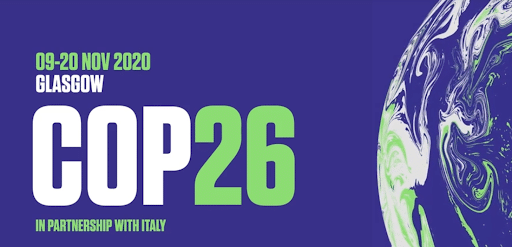
Countdown to COP 26 Comment: NDCs and the biogas imperative
Jon Hughes considers the opening shots in the battle for climate supremacy at COP26 and concludes any plan that omits biogas will be hollow.

The climate gauntlet has been thrown down; 68 is the world-beating number alighted on by the UK. The host of COP 26 has pledged to cut greenhouse gas emissions by 68% by 2030, a rate currently faster than any other developed nation.

Why 68 is not clear. It could well have been 69 with Boris Johnson. There’s an appropriate circularity to that number, approximating the yin yang symbol, representing nature and our role within it.
Undoubtedly 68 is a bigger number than existed. Undoubtedly if met it will accelerate the UK towards Net Zero by 2050. But whether the target is to keep global warming below 2C or 1.5C has not definitively been stated. That relies on what comes next.
Science, climate and cash
The target has received a lukewarm response in the UK. The UK is after all falling short on its current carbon budgets (four and five, set in 2011 and 2016 respectively), seeking a combined 57% reduction in annual UK emissions by 2032. And the science says to keep global warming at 1.5C the required reduction in emissions is 73% by 2030. In its sixth carbon budget the UK’s Climate Change Committee – a statutory body setting legally binding targets – says 78% by 2035, but has recommended the 68 stepping stone.
The UK’s 10-point plan, hinged on hydrogen, CCUS and heat pumps, is undercooked and underfunded, say its critics. The UK lags far behind the US and most European countries in its spending commitments on a green recovery. It has pledged £4bn, compared to £16bn for defence and £27bn for road building. By comparison, President Joe Biden has earmarked $2trillion, France €20 billion, Germany €100bn.
Denmark ups the ante

Yet symbolically the UK’s 68 is a start, with a year to go until COP26 convenes in Glasgow. It challenges countries around the world to match the ambition as they prepare to submit their NDCs (National Determined Contributions) to the Paris Agreement.
As a strategy it could be said to be working. The day after the UK announced its 68 pledge Denmark trumped it. The country banned exploration for new North Sea reserves of oil and gas as part of its commitment to phase out fossil fuels, cut carbon emissions and tackle climate change.
As an early adopter of renewable energy, Denmark is on target to achieve 100% renewable electricity from wind and solar by 2030, and renewable gas (biogas) by 2040. Indeed, the country kickstarted its biogas revolution when it hosted Cop15 in 2009 and is now reaping the dividends.
The Danes have certainly upped the ante for COP26. Now it is for others to follow.
Out of time
Another thing to note about the UK announcement is the timeframe. It says it will achieve 68% by 2030. Yet again, this is at variance with the science, which says we have seven years left to make the required changes to hit 1.5C.
That means mature technologies must be deployed now while others are developed. Renewables – wind, solar and biogas – trump tomorrow’s technology – hydrogen, CCUS and nuclear fusion. Renewables start the transition, tomorrow’s tech turbo charges it post-2030. To be meaningful this truth must be reflected in all countries NDCs.
Wind and solar are cheaper and cleaner than any other means of providing electricity today. And biogas is the only readily available solution for decarbonising the gas grid, or delivering green electricity and fuel in remote rural areas.
If that were the sum total of its benefits that would be cause enough. But biogas does so much more.
Methane and carbon capture, soils and SDGs
 Biogas hoovers up methane from rotting organic wastes and through the production of natural fertiliser (off-setting carbon intensive mineral fertiliser), boosts the carbon capture capability of soils.
Biogas hoovers up methane from rotting organic wastes and through the production of natural fertiliser (off-setting carbon intensive mineral fertiliser), boosts the carbon capture capability of soils.
Increasing the annual carbon stock in agricultural soils by 0.4% (or 4 per 1000) in the top 40 centimetres of soil would, in theory, be equivalent to the increase of annual carbon emissions caused by human activity, i.e., it would make human activity carbon neutral.
In the global south, biogas addresses 9 of the 17 SDGs (Sustainable Development Goals). It enables clean cooking, which is at root a cause of eco-stress. Covid-19 is a zoonotic disease, passed from animal to humans as habitats crash into each other, largely occasioned by the need for firewood and food. Biogas delivers energy for clean cooking and farm resilience for food.
Aside from this, which chimes with the push of the African Development Bank’s New Deals for a Green Revolution and Electrification, biogas addresses sanitation, clean water and education of the girl child.
Biogas works everywhere
America recognises the critical role biogas must play, the Agricultural Resilience Act currently before congress is hinged on biogas. The European Commission recognises the critical role biogas must play, its strategy for methane mitigation is hinged on biogas; methane is a more potent GHG than CO2 and manmade emissions are rising fast.
Given the narrow window of opportunity we have to act – just seven years – any NDC that is proposed and doesn’t feature biogas cannot be read as having serious intent to address the existential crisis posed by climate change.
Governments cannot cherry pick when to follow the science. Especially as the science has guided the world through the Covid-19 pandemic, which is a climate disease, and climate change threatens far greater devastation.

